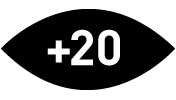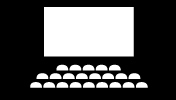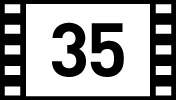

The 1980s were known for many things, but one of the most prominent characteristics of that decade was its embrace of sequels. Nothing close to the "franchise" or "universe" concepts we endure today, but the idea that pretty much any successful movie could spawn a film series had started to become standard operating procedure for studios by the middle of the decade. Perhaps no other movie felt more organically suited to sequels than Raiders of the Lost Ark since its primary inspiration was the old adventure serials produced in the 1940s by studios like Columbia, Republic, and Universal. These "chapter plays," as Annie Wilkes calls them in Stephen King's Misery, were designed to be continuing adventures, and the character of Indiana Jones, as embodied by Harrison Ford and envisioned by George Lucas, Steven Spielberg, and Lawrence Kasdan, Raiders was too good a cinematic creation not to explore further.
The second installment of the Indiana Jones film series is simultaneously one of the best, most original sequels and one of the most frustratingly disappointing. Making a follow-up to one of the greatest movies of all time is never an easy task. No matter how successful, the sequel can never create the amazement and wonder of something that never existed in such a form before and then suddenly becomes a permanent part of the culture. Raiders was a far bigger success than anyone, including its creators, had any idea was possible. Lucas and Spielberg had set out to make a fun little picture that harkened back to their childhoods of escaping into cheap Saturday adventure matinees and Disney comic books. But Raiders was one of those movies where, rather than a constant fight against the elements, studio interference, logistics, and the temperaments of cast and crew, everything went not only right but far better than any filmmaker ever dreamed possible. Aside from a few stuffy old farts, Raiders was universally embraced by both critics and audiences. So, no matter what followed, it was going to be at least a little bit less of a surprise and delight.
I know there are some people out there who prefer Temple of Doom or Last Crusade to the original Raiders of the Lost Ark. I can understand this on certain levels, I guess, but whenever I meet someone who informs me of this preference, I know instantly that they fundamentally experience movies differently than I do. It's a little like the character in Whit Stillman's first film, Metropolitan, who explains proudly that he prefers reading literary criticism to literature itself because, in literary criticism, you simultaneously get a sense of the author's intentions as well as a critical perspective on them. Of course, not growing up with these films makes a huge difference, and I don’t expect people who watched all three (or even all five) of the Indiana Jones pictures for the first time in a single weekend to feel the same way about them as those of us who grew up with these films coming out in theaters. But I still think Raiders of the Lost Ark is such a seminal entry in the history of cinema that any follow-up can not help but pale in comparison.
What makes Indiana Jones and the Temple of Doom such a fantastic sequel is how much it avoids almost all of the pitfalls that make most movie sequels so frustrating. Lucas and Spielberg set out to make this a very different film from its predecessor, rather than the typical "the same but different" approach to sequel-making. Aside from the protagonist, visual look, music, and the conceptual homage to the Golden Age of Hollywood serials, Temple of Doom rehashes almost nothing from Raiders. The tone is entirely different, not one of the supporting characters returns, and there are almost no overt callbacks to the first movie. The film isn’t actually a sequel at all, but a sneaky prequel made before that term was in vogue. Only a post-opening credits title card, informing viewers that this story starts in "Shanghai 1935," tells us (those of us old enough in 1984 to know that WWII started after that date) that this movie occurs prior to the events of the first film in which Indiana Jones faced off against Nazis.
Lucas and Spielberg would become primary purveyors of the most infantile sequel trends in their subsequent films, like the Back to the Future sequels—in which every single character and narrative beat from the first movie is rehashed in the follow-ups—or the Star Wars prequels—which shrink the entire universe and mythology created in the imagination of audiences by the first films down to a tiny of interrelated characters who keep bumping into each other as if the all the planets of all the galaxies in the entire universe are within 10 blocks of each other. Of course, these filmmakers would be guilty of this practice in the next Indiana Jones movie, The Last Crusade, with its cute little opening sequence in which we see how young Indy (played by River Phoenix) came to acquire his whip, his facial scar, his fedora hat, his fear of snakes, and his entire atheistic while he was a boy scout. That sequence obliterates the imagined history of countless adventures and life experiences (the "mileage," as Indy would say) that we imagine shaped the character we met in Raiders down to the events of a single afternoon!
Like Raiders, Temple of Doom has the type of simple but meaningful character arc rarely found in most heavy-handed movie prequels or origin stories. In Raiders, Indiana Jones starts out as an archeologist and professor with a healthy respect for the local legends and supernatural folklore surrounding the artifacts he goes after, but he doesn't personally "believe in all that superstitious mumbo jumbo." He becomes someone who has witnessed first-hand the power of ancient beliefs that exist beyond the realms of what can be scientifically understood, and we get the sense that this experience may make him view and treat the people in his life with a tad more regard than before. The Indy we meet at the beginning of Temple of Doom doesn't even have that healthy respect for local customs and beliefs. He's a fortune hunter, well-versed in the history and practices of the cultures he's raiding, but only because it will help get him what he wants. He's a thrill-seeker going after "fortune and glory." He's not even working for anything as respectable as a museum when he plunders; he’s going for the biggest payoff. His closest companion is not a peer like the Egyptian excavator Sallah, played so well by John Rhys-Davies in Raiders, but a savvy street urchin, the amusing but annoying 13-year-old Short Round, played by Ke Huy Quan. The adventure Indy undertakes in Temple of Doom helps to form the character we met in Raiders, an archeologist and teacher more concerned with recovering artifacts for a museum or for their rightful cultural owners than for the highest bidder.
The adventure in Temple of Doom is not one Indy goes on voluntarily, as in Raiders. He and Short Round end up in British colonial India after escaping a Shanghai crime boss (Roy Chiao) accompanied by an American nightclub singer (Kate Capshaw). Discovered by poverty-stricken villagers whose children have all been abducted, Indy is asked by the village Shaman (D. R. Nanayakkara) to locate a mystical stone and rescue the kidnapped children. The reluctant trio of Indy, Shorty, and the singer, Willie Scott, soon happens upon the lavish palace of a young Maharaja (Raj Singh) who's also entertaining a visiting dignitary of the British Indian Army (Philip Stone). The Maharaja's Prime Minister (Roshan Seth) assures Indy that the village legends have no basis in fact, but Indy soon discovers that the ancient Thuggee cult is still worshiping the evil god Kali with black magic, human sacrifices, and child slavery in a temple beneath the palace.
For a movie ostensibly aimed at kids and teens, Temple of Doom is incredibly dark, violent, and upsetting. It was heavily criticized upon release for these disturbing "qualities." The MPAA was also lambasted by parents for granting this movie a PG rating, and, indeed, this was one of the key movies of 1984 that led to the creation of PG-13. The picture is also overtly racist and misogynistic in multiple ways. Many today describe Temple of Doom as "not having aged well," but this film provides a prime example of how wrongheaded that phrase is. Movies don't "age well" or "not age well" like wine or cheese. I've always preferred to say movies either "still play well" or "don't play well today" because it’s not the films that change over time; it's the attitudes of the mass audience. Movies stay exactly the same (the infuriating latter-day tinkering of filmmakers like Lucas notwithstanding) as they were when they were created. A film does not become racist or misogynistic over time; it either is or isn't / was or wasn't. Viewers in the era in which a particular film was released may have been ignorant or willfully blind to such concerns at the time, just as contemporary viewers may be ignorant or dogmatically dismissive of the context in which a particular film came out, but all movies are a product of the society and culture in which they were created. This film made a great many viewers in 1984 deeply uncomfortable with its depiction of Indian characters and its obnoxious lone female constitute. These aspects come off even worse today than they did 40 years ago because of how we, as a culture, have come to understand how such depictions have had a cumulatively negative effect on societal attitudes and political policies.
Still, I think Temple of Doom comes about its flaws as honestly as its strengths. In the development, Spielberg and Lucas again took inspiration from the serials and adventure pictures of their youth. And just as countless 1940s thrillers used Germans as their go-to villains, many Hollywood pictures of the 1930s played upon broad stereotypes of "the exotic Asian" for sinister Fu-Man-Chew-style villains, otherworldly Dragon-Lady temptresses, and helpless, poverty-stricken villagers. George Stevens's Gunga Din, one of the biggest hits of the seminal movie year 1939, was clearly a major inspiration for Temple of Doom. That film, based on a poem by the colonial romanticist Rudyard Kipling, is about three British sergeants in India who, along with their native water bearer, the titular Gunga Din, fight the murderous Thuggee cult.
The filmmakers also wanted to draw on the screwball tradition of 1930s romcoms and create a female lead whose romantic connection to Indy would be amusingly combative. Unfortunately, perhaps because Lucas and Spielberg were each going through messy divorces at the time of this project's writing and shooting, this romantic tonal dynamic comes off as far more hostile and shrill than charmingly screwball. It didn’t help matters that they hired Lucas's old USC buddies, Willard Huyck and Gloria Katz, to write the screenplay. The husband and wife team had penned American Graffiti for Lucas and made the formative horror sleeper Messiah of Evil. Those two films aside, Huyck and Katz are not exactly on par with say, Garson Kanin and Ruth Gordon. In addition to shouldering a lot of the blame for the most unpleasant aspects of Temple of Doom, these two are most remembered for their other Lucas-produced disasterpiece, Howard the Duck, as well as another Lucas attempt to pay homage to the 1930s, Radioland Murders. They are also responsible for one of the worst movies of this year, 1984, the Dudley Moore vehicle Best Defense, into which Eddie Murphy was shamelessly grafted in a last-minute attempt to salvage a film everyone knew was total garbage.
Plenty of blame for the annoying characterization of Willie Scott must also fall to the actress who portrayed her, Kate Capshaw. Though she and Spielberg fell in love while making this picture (and their marriage is still going strong), there is little that's lovable or endearing about her performance. This is the one time that the filmmakers' attempts to do something totally different from what they did in Raiders backfired. Not only was Indy's love interest in Raiders a complex and formidable heroine—she was also played by the great Karen Allen. Allen was not only an established star with the power and inclination to make substantive contributions to the character and the narrative, but she provided the indomitable screen presence she brought to every film she made in the ‘70s and ‘80s, regardless of her characters' temperaments. Marion Ravenwood, as envisioned by Lucas and Speilberg, written by Kasdan, and portrayed by Allen, is the opposite of a stock "girl in the picture." Marion, the daughter of Indy's mentor, whom he became sexually involved with when she was a teenager and he was in his twenties, is the hard-drinking, take-no-shit owner of a Nepalese bar whom Indy must join forces with in order to acquire an archeological relic that her father once owned, which will help him in his quest for the lost Ark of the Covenant. Looking at the initial transcript of the Raiders writing sessions, it's easy to see how Marion could have started out as a dynamic and fascinating character only to be reduced to a damsel in distress by the film's second half. But Kasdan and Allen ensured that didn’t happen, with all kinds of late additions to the script that kept her from merely existing in Indy's shadow.
If only Huyck, Katz, and Capshaw were able to pull off something similar. I can only take their word, and that of Spielberg, that none of them realized just how annoying the character was coming off as they shot the picture and looked at the dailies. Willie Scott should have played like a throwback to the wonderful screwball dames personified by actresses like Carol Lombard and Jean Arthur in the 1930s, but instead, she embodies the unfortunately adolescent boy "eww, girls are gross" characteristics of most of the Lucas movies (a trend that, interestingly, would be broken with the sophomorically randy Howard the Duck). There is one scene in Temple of Doom in which we can see what the writers and filmmakers were going for. After Indy and Willie are comfortably cleaned up and refreshed in the palace before discovering the evils that exist in its bowels, there's a delightful scene of verbal sparring that plays perfectly as 1930-style combative foreplay, which gets interrupted when a sword-wielding assassin tries to do away with Indy. But this scene is not typical of the rest of the picture, in which Capshaw spends most of her time whining, yelling, and being a drag.
The Indian actors are far more impressive. Though they are unquestionably playing American stereotypes, some of the country's greatest stars jumped at the chance to be in the sequel to Raiders of the Lost Ark and fully committed to their roles. Most notably, Amrish Puri plays Mola Ram, the Thuggee priest who performs rites of human sacrifice. Puri was one of the most important actors of Indian stage and screen, making over 450 films in his career. He shaved his head for this sinister role and liked the look so much he kept the style, and it became a kind of trademark for him. Mola Ram is one hell of a compelling villain, and the scenes of the human sacrifices became so iconic that countless '80s movies, from Young Sherlock Homes to Dragnet, copied them shamelessly.
The fact that half of Temple of Doom is contained in a single location is another clever way this film differentiates itself from the Globe-trotting Raiders of the Lost Ark. The sets are astoundingly impressive. The practical visual effects are cutting edge—with almost all of them still looking great forty years later. Temple of Doom benefited from the fact that so many of the concepts Lucas and Spielberg had for Raiders could not fit into Kasdan's extraordinary screenplay. So there were lots of great ideas just sitting there waiting to be used for the sequel. The character of Indiana Jones was originally conceived to have three distinct sides: a cynical adventurer in the style of Humphrey Bogart, a sexy but somewhat befuddled academic in the vein of Cary Grant, and an ultra-confident playboy in the James Bond mold. They never found a place for the playboy side of Indy in Raiders, which is all to the good, but it fits perfectly in the opening sequences of this movie.
Another key sequence the team really wanted was a chase in run-away mine carts along a track that resembles a roller coaster. This fits perfectly as the escape from the Temple of Doom, which is on par with any destruction-of-the-villains-lair climax in any James Bond movie. While the mine cart sequence defies all logic, there's no denying the fun of this extended special effects tour-de-force. It's followed by an equally thrilling scene set on a precariously ancient rope suspension bridge strung across a deep, wide canyon. The counterbalance between the fast-paced energy of the mine cart chase and the contained tension of the suspension bridge sequence is inspired, with both giving the film an incredible third act.
Of course, the Raiders production team of cinematographer Douglas Slocombe, editor Michael Kahn, sound designer Ben Burtt, composer John Williams, and the visual effects wizards of Industrial Light and Magic gives this radically different sequel an identical look, sound, and feel to its predecessor. I've always been amazed at how distinctive these Indiana Jones movies look and sound. You instantly know you’re looking at an Indy movie from any single frame from any of the first three pictures (and most frames from the 4th, which was made 20 years later). And while so many of the sound effects used by Burtt in all the Lucas films are the same or similar, you know from listening to almost any second of sound from any of these films that you are hearing an Indiana Jones movie. Especially in the era we live in now, when all blockbusters have virtually the same dark, muddy CGI look and a busy sound mix that drowns out most of the dialogue, this aspect of these movies seems all the more special. Temple of Doom may be a far from perfect film, but it is a worthy sequel to one of the greatest movies ever made.
Twitter Capsule:
So many embarrassing choices combined with so many wonderfully executed ideas (covered in so much shrill screaming). In too many ways, Temple of Doom is an unworthy sequel to Raiders—but what the hell would be worthy?—I will always appreciate that it goes in such wildly different directions than its illustrious predecessor and isn't a carbon copy sequel like the third film.










